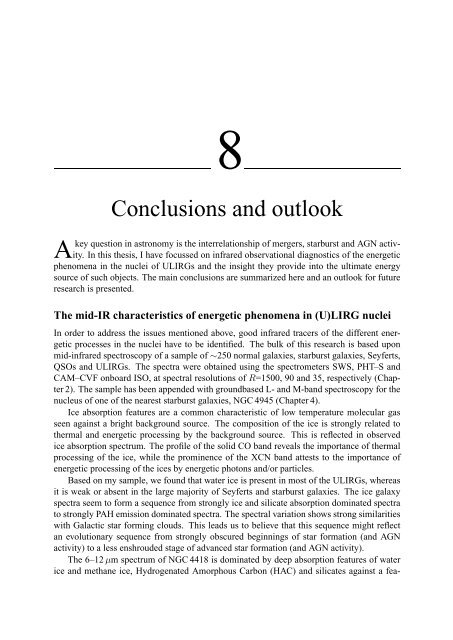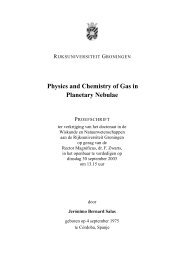Conclusions and outlook - IRS, The Infrared Spectrograph
Conclusions and outlook - IRS, The Infrared Spectrograph
Conclusions and outlook - IRS, The Infrared Spectrograph
You also want an ePaper? Increase the reach of your titles
YUMPU automatically turns print PDFs into web optimized ePapers that Google loves.
8<br />
<strong>Conclusions</strong> <strong>and</strong> <strong>outlook</strong><br />
Akey question in astronomy is the interrelationship of mergers, starburst <strong>and</strong> AGN activity.<br />
In this thesis, I have focussed on infrared observational diagnostics of the energetic<br />
phenomena in the nuclei of ULIRGs <strong>and</strong> the insight they provide into the ultimate energy<br />
source of such objects. <strong>The</strong> main conclusions are summarized here <strong>and</strong> an <strong>outlook</strong> for future<br />
research is presented.<br />
<strong>The</strong> mid-IR characteristics of energetic phenomena in (U)LIRG nuclei<br />
In order to address the issues mentioned above, good infrared tracers of the different energetic<br />
processes in the nuclei have to be identified. <strong>The</strong> bulk of this research is based upon<br />
mid-infrared spectroscopy of a sample of ∼250 normal galaxies, starburst galaxies, Seyferts,<br />
QSOs <strong>and</strong> ULIRGs. <strong>The</strong> spectra were obtained using the spectrometers SWS, PHT–S <strong>and</strong><br />
CAM–CVF onboard ISO, at spectral resolutions of R=1500, 90 <strong>and</strong> 35, respectively (Chapter<br />
2). <strong>The</strong> sample has been appended with groundbased L- <strong>and</strong> M-b<strong>and</strong> spectroscopy for the<br />
nucleus of one of the nearest starburst galaxies, NGC 4945 (Chapter 4).<br />
Ice absorption features are a common characteristic of low temperature molecular gas<br />
seen against a bright background source. <strong>The</strong> composition of the ice is strongly related to<br />
thermal <strong>and</strong> energetic processing by the background source. This is reflected in observed<br />
ice absorption spectrum. <strong>The</strong> profile of the solid CO b<strong>and</strong> reveals the importance of thermal<br />
processing of the ice, while the prominence of the XCN b<strong>and</strong> attests to the importance of<br />
energetic processing of the ices by energetic photons <strong>and</strong>/or particles.<br />
Based on my sample, we found that water ice is present in most of the ULIRGs, whereas<br />
it is weak or absent in the large majority of Seyferts <strong>and</strong> starburst galaxies. <strong>The</strong> ice galaxy<br />
spectra seem to form a sequence from strongly ice <strong>and</strong> silicate absorption dominated spectra<br />
to strongly PAH emission dominated spectra. <strong>The</strong> spectral variation shows strong similarities<br />
with Galactic star forming clouds. This leads us to believe that this sequence might reflect<br />
an evolutionary sequence from strongly obscured beginnings of star formation (<strong>and</strong> AGN<br />
activity) to a less enshrouded stage of advanced star formation (<strong>and</strong> AGN activity).<br />
<strong>The</strong> 6–12 µm spectrum of NGC 4418 is dominated by deep absorption features of water<br />
ice <strong>and</strong> methane ice, Hydrogenated Amorphous Carbon (HAC) <strong>and</strong> silicates against a fea-
144 CHAPTER 8: <strong>Conclusions</strong> <strong>and</strong> <strong>outlook</strong><br />
tureless mid-infrared continuum. <strong>The</strong> spectrum closely resembles that of embedded massive<br />
protostars in our Galaxy. From the depth of the absorption features it is infered that the powerful<br />
central source responsible for the mid-infrared emission must be deeply enshrouded.<br />
Since this emission is warm <strong>and</strong> originates in a compact region, an AGN must be hiding in<br />
the nucleus of NGC 4418. <strong>The</strong> overall shape of the NGC 4418 6–11 µm spectrum shows a<br />
‘false’ emission peak at 7.7 µm, which mimicks at first glance a PAH spectrum. <strong>The</strong> need<br />
for high S/N spectra is obvious to clearly distinguish between bona fide PAH spectra <strong>and</strong><br />
absorption dominated spectra.<br />
<strong>The</strong> 3–6 µm nuclear spectrum of starburst/Seyfert-2 galaxy NGC 4945 shows, in addition<br />
to PAH emission, deep absorption features of water ice, CO 2 ice, OCN − ice <strong>and</strong> CO ice.<br />
Tracers of AGN activity are not detected. Analogous to the processing of ices by embedded<br />
protostars in our Galaxy <strong>and</strong> assuming the AGN to be deeply buried, the processing of the<br />
ices in the center of NGC 4945 is attributed to ongoing massive star formation.<br />
PAH emission features are generally assumed to be tracers of exposed star formation. We<br />
have investigated this assumption for a sample of Galactic regions of massive star formation<br />
on the basis of a MIR/FIR diagnostic diagram of far-infrared normalized 6.2 µm PAH flux<br />
versus far-infrared normalized 6.2 µm continuum flux. Within this diagram the Galactic H II<br />
regions span a sequence from embedded compact H II regions to exposed PDRs. <strong>The</strong> 6.2 µm<br />
PAH b<strong>and</strong>-to-continuum ratio is remarkably constant over this range. We have compared<br />
our extragalactic sample to these Galactic sources. This revealed that normal <strong>and</strong> starburst<br />
galaxies have a uncanny resemblance to reflection nebulae. While Seyfert-2’s coincide with<br />
the starburst trend, Seyfert-1’s are displaced by a factor 10 in 6.2 µm-continuum flux. This<br />
is in accordance with AGN unification schemes. ULIRGs show a diverse spectral appearance.<br />
Some are found with the Seyfert-1’s. More, however, are either starburst-like or show<br />
signs of strong dust obscuration in the nucleus. <strong>The</strong> latter group is displaced with respect to<br />
all other galaxy types towards the position of embedded massive protostars <strong>and</strong> the deeply<br />
enshrouded nucleus of NGC 4418. One characteristic of the ULIRGs seems also to be the<br />
presence of more prominent far-infrared emission than either starburst galaxies or AGNs. We<br />
have examined the use of PAHs as quantitative tracers of star formation activity. Based on<br />
these investigations, we find that the PAH emission of normal <strong>and</strong> starburst galaxies is best<br />
represented by that of exposed PDRs associated with reflection nebulae such as the Orion<br />
Bar <strong>and</strong> NGC 2023. However, the infrared spectra of some sources — notably the architypal<br />
ULIRG Arp 220 — may be dominated by embedded massive star formation rather than exposed<br />
PDRs. NGC 4418 may be an even more extreme example of such buried star formation,<br />
where even the faintest traces of PAH are lacking.<br />
Embedded AGN <strong>and</strong> starburst activity<br />
<strong>The</strong> near- <strong>and</strong> mid-infrared spectrum of NGC 4945 does not provide any evidence for the<br />
existence of the powerful AGN, inferred from hard X-ray observations. <strong>The</strong> upper limits<br />
on our AGN tracers 3.94 µm [Si IX], 7.65 µm [Ne VI] <strong>and</strong> 14.3 & 24.3 µm [Ne V] imply an<br />
A(V)>160 towards the NLR, assuming the NLR to be of equal strength as in the Circinus<br />
galaxy.<br />
NGC 4418 has a very compact (r
145<br />
Arp 220 does not reveal any sign of an AGN either, not even in hard X-rays or in radio<br />
continuum emisson. <strong>The</strong> radio emission instead reveals several emission ‘knots’ across the<br />
two nuclei, which are interpreted as luminous radio supernovae. PAHs as tracers of exposed<br />
star formation are strongly underluminous with respect to the far-infrared luminosity. Spectral<br />
decomposition of the 6–12 µm ISO spectrum suggests that 40% of the 6–12 µm flux is<br />
associated with an NGC 4418-like absorbed continuum component <strong>and</strong> 60% with a weakly<br />
absorbed starburst component. <strong>The</strong> PAH emitting <strong>and</strong> heavily dust/ice absorbed components<br />
are tentatively associated with the diffuse emission region <strong>and</strong> the two compact nuclei respectively<br />
identified by Soifer et al. (2002) in their higher spatial resolution 10 µm study. Both the<br />
similarity of the absorbed continuum with that of embedded Galactic protostars <strong>and</strong> results<br />
of dust modeling imply that the embedded source(s) in Arp 220 could be powered by, albeit<br />
extremely dense, starburst activity. Due to the high extinction, it is not possible with the<br />
available data to exclude that AGN(s) also contribute some or all of the observed luminosity.<br />
In this case, however, the upper limit measured for its hard X-ray emission would require<br />
Arp 220 to be the most highly obscured AGN known.<br />
Outlook<br />
<strong>The</strong> research presented in this thesis has opened a number of research lines that should be<br />
explored in the future. For instance, the role of embedded star formation has to be further<br />
explored. <strong>The</strong> high interstellar pressure in the central region of ULIRGs may limit the expansion<br />
of UCH II regions <strong>and</strong> the development of the normal bright signposts of star formation.<br />
Further diagnostic tools have to be developed for the study of such regions. In Chapter 4, we<br />
have demonstrated by the example of NGC 4945 that medium resolution (R=3000) M-b<strong>and</strong><br />
spectroscopy is a viable option to study the molecular environment in nearby galactic nuclei.<br />
Similar studies of other starburst nuclei are needed to determine whether the conditions<br />
probed in NGC 4945 are extreme or typical for starburst nuclei. With respect to AGNs, the<br />
energetic processing of (ices in) the molecular torus needs to be investigated.<br />
<strong>The</strong> recent launch of the Satellite InfraRed Telescope Facility (SIRTF) marks the start<br />
of a decade in which infrared <strong>and</strong> submillimeter astronomy will undergo an authentic revolution.<br />
Space-based missions such as the Herschel Space Observatory (HSO), the James<br />
Webb Space Telescope (JWST), new groundbased facilities as the Atacama Large Millimeter<br />
Array (ALMA) <strong>and</strong> new VLT instruments like the VLT Imager <strong>and</strong> Spectrometer for the mid-<br />
InfraRed (VISIR) will, together with SIRTF, be the cornerstones of the future investigation<br />
of starburst <strong>and</strong> AGN activity in the Early Universe.<br />
Particularly, the <strong>IRS</strong> spectrograph on SIRTF will provide medium-resolution (R=600)<br />
spectroscopy in the 10–37 µm range <strong>and</strong> low-resolution (R=50) spectroscopy in the 5–40 µm<br />
range. <strong>IRS</strong> is therefore ideally suited to measure the emission line spectra of AGN <strong>and</strong><br />
starburst phenomena, while PAH emission b<strong>and</strong>s <strong>and</strong> ice absorption features can be observed<br />
at lower resolution. As a bonus, beyond z=0.6, all important near-infrared ice absorption<br />
b<strong>and</strong>s are redshifted into the <strong>IRS</strong> low-resolution range, while the main PAH emission b<strong>and</strong>s<br />
can be measured in medium-resolution spectroscopy. <strong>The</strong> PACS instrument on Herschel<br />
will provide high-resolution (R=1700) spectroscopy in the 60–210 µm range. This will give<br />
access to the main cooling lines of star forming regions <strong>and</strong>, for targets at z>1.5, also to<br />
rest-frame mid-infrared AGN tracers. <strong>The</strong> N<strong>IRS</strong>pec <strong>and</strong> MIRI spectrographs on the JWST<br />
will offer medium resolution spectroscopy in the ranges 0.6–5 µm <strong>and</strong> 5–28 µm, respectively.
146 CHAPTER 8: <strong>Conclusions</strong> <strong>and</strong> <strong>outlook</strong><br />
This will allow the detection of mid-infrared star formation <strong>and</strong> AGN tracers out to redshifts<br />
of 2–3. ALMA will bring HST resolution to the field of submillimeter astronomy. This will<br />
allow the detection of galaxies out to extreme redshifts by sampling them close to the peak<br />
of their flux distributions.<br />
<strong>The</strong>se instruments offer enough sensitivity to study the energetic processes in ULIRGs<br />
<strong>and</strong> HyLIRGs in sufficient spectral detail that the contributions of (embedded) AGN <strong>and</strong><br />
starburst activity may be traced back all the way to the youthful days of our Universe. This<br />
will allow us to determine whether all mergers go through a ULIRG/HyLIRG phase <strong>and</strong> how<br />
the role of (embedded) starburst <strong>and</strong> AGN activity changes as a function of merger phase. <strong>The</strong><br />
observations will also allow us to study the composition of the ISM in the Early Universe <strong>and</strong><br />
to assess the influence of extreme nuclear activity on chemical enrichment.<br />
High spatial resolution in combination with sufficient spectral resolution will permit<br />
analysis of individual nuclear <strong>and</strong> circumnuclear components in (ultra)luminous galaxies<br />
in a large portion of the Local Universe. For instance, the nature of merger nuclei may be<br />
inferred; properties of individual (super)star clusters may be inferred; <strong>and</strong> the influence of<br />
the central X-ray sources on the chemical composition of AGN tori may be finally studied.<br />
For ULIRG astronomy the best is still to come!<br />
FIGURE 8.1 — <strong>The</strong> launch of<br />
SIRTF on August 25, 2003<br />
marks the start of a decade<br />
in which infrared <strong>and</strong> submillimeter<br />
astronomy will undergo<br />
an authentic revolution.<br />
Photo: NASA.













